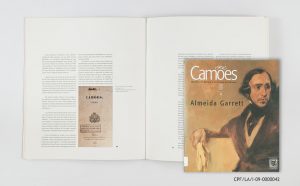Documento Mês – Fundo Bibliográfico

ALMEIDA GARRETT (1799-1854)
Sabia que Almeida Garrett usou a figura do poeta Luís de Camões para refletir as suas frustrações políticas e pessoais?
Almeida Garrett (1799-1854), destacado poeta, dramaturgo e político português, nasceu no Porto e viveu num período de grande instabilidade em Portugal, marcado pela Revolução Liberal do Porto em 1820 e pela subsequente Carta Constitucional de 1822. Comprometido com a causa liberal, Garrett foi forçado ao exílio após a tentativa de restauração absolutista conhecida como Vilafrancada, em 1823. Durante o exílio, residiu na Inglaterra e na França, onde foi influenciado pelo romantismo europeu.
Em 1825, em Paris, publicou “Camões”, um poema lírico-narrativo que se destaca como uma obra pioneira do romantismo em Portugal. Inspirado na estrutura de “Os Lusíadas”, o poema oferece uma reflexão sobre a figura de Luís de Camões (1524/1525 – 1580), o poeta nacional. Almeida Garrett critica a falta de reconhecimento do poeta em vida, apesar da sua importância para a identidade cultural e histórica de Portugal, e usa a figura de Luís de Camões como um reflexo das suas próprias frustrações e da situação política e social da sua época, estabelecendo uma ligação simbólica entre o passado e o presente.
ALMEIDA GARRETT (1799-1854)
Did you know that Almeida Garrett used the figure of the poet Luís de Camões to reflect his political and personal frustrations?
Almeida Garrett (1799–1854), a prominent Portuguese poet, playwright, and politician, was born in Porto and lived through a period of great instability in Portugal, marked by the Liberal Revolution of Porto in 1820 and the subsequent Constitutional Charter of 1822. Committed to the liberal cause, Garrett was forced into exile after the absolutist restoration attempt known as the Vilafrancada in 1823. During his exile, he lived in England and France, where he was influenced by European Romanticism.
In 1825, while in Paris, he published Camões, a lyrical-narrative poem that stands out as a pioneering work of Romanticism in Portugal. Inspired by the structure of Os Lusíadas, the poem reflects on the figure of Luís de Camões (1524/1525–1580), the national poet. Almeida Garrett criticizes the lack of recognition Camões received during his lifetime, despite his importance to Portugal’s cultural and historical identity. He uses the figure of Luís de Camões as a reflection of his own frustrations and the political and social situation of his time, establishing a symbolic connection between the past and the present.